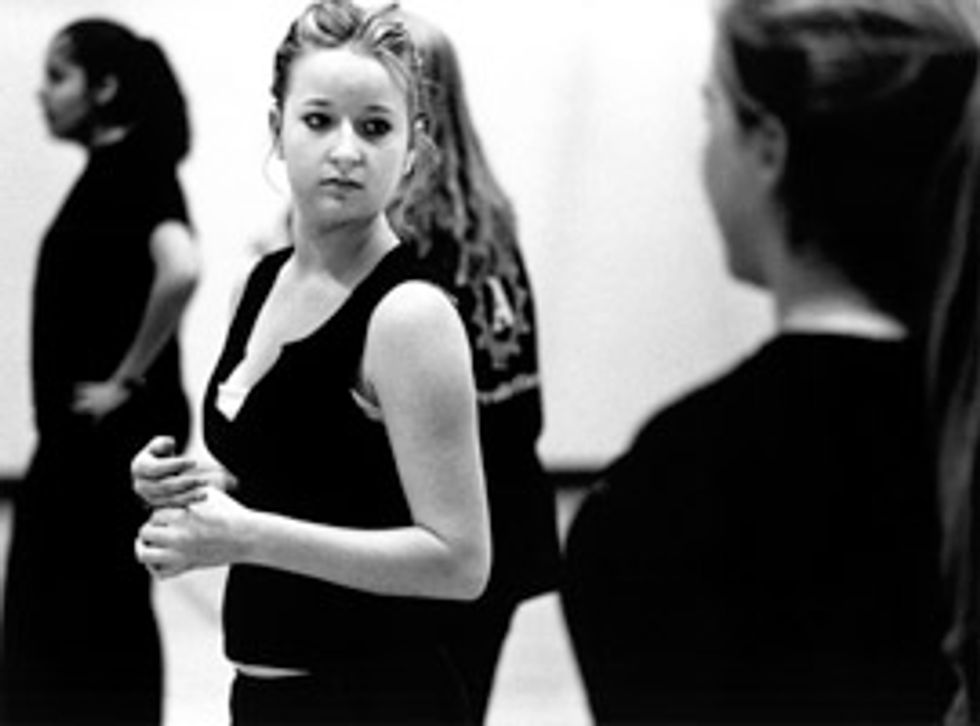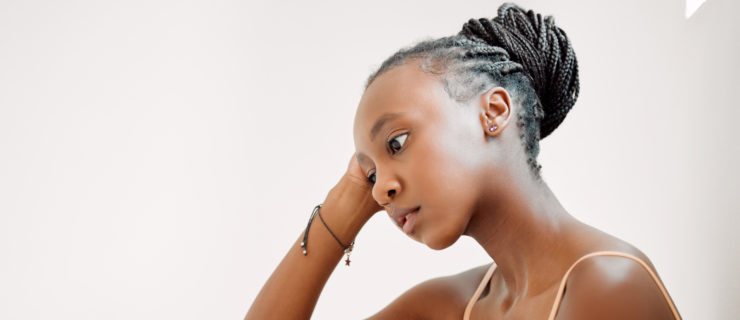Beat Bullying
Imagine that you’re in ballet class, working on your triple pirouettes. As your teacher watches you and gives you pointers, you look in the mirror and catch a glimpse of one of the other girls in your class exaggeratedly imitating your every wobble as her friends watch and quietly giggle. You feel your face growing hot, and it takes every ounce of your self-control to finish the exercise instead of running from the room. This mean girl has been acting like this for weeks and you have no idea how to get her to leave you alone.

Bullies can destroy your self-esteem and take all the joy from your dance life. (Photo by David Paone)
Bullying is a hot topic on the national scene. Government officials have teamed with educators, parents and celebrities to spread the message that bullying—by anyone, toward anyone—must not be tolerated. Unfortunately, bullying is just as present in the dance studio as it is in an academic school setting, in part because dancers are naturally competitive, vying for the same roles and comparing themselves to their peers.
Lynda Mainwaring, a psychologist with expertise in dance and performance psychology, says that bullying is “any act that intends to do harm, continued repeatedly within a relationship—and it’s often very subtle.” Even though bullying isn’t always physical, it still hurts. Bullies can destroy your self-esteem and take all the joy from your dance life.
To stop the cycle, first realize that you don’t deserve to be treated this way, and that it’s OK to ask for help. Every bullying scenario is different, but in each case, there are steps you can take to break free.
Peer Bullying
A classmate rolls her eyes and whispers to her friends every time you make a mistake. You walk into the dressing room and catch a group of girls making fun of your outfit. You log on to Facebook to discover an ugly photo tagged with your name and a mocking caption. Now you’re wondering, “Why me?”
“The targets of peer bullying are usually the kids who don’t fit in easily,” says Linda Hamilton, a psychologist specializing in the performing arts. “They might even be the most talented kids.” A bully may be jealous of you, she may be trying to make others like her by putting you down, or she may be dealing with a completely unrelated issue and taking it out on you. But just because there’s a reason for the behavior doesn’t mean that it’s OK—or that you have to suffer quietly.
One of the most effective methods to deal with a bully is to ignore her. If a bully is trying to get a rise out of you, she’ll get frustrated if you don’t react. “It’s like giving a 3-year-old a time-out,” Hamilton says. “You take away the attention the person craves.” If you don’t get visibly upset, the bully may lose interest in you as a target.
You can also confront a bully directly. For instance, in the face of a nasty rumor, ask, “Where did you hear that?” to put the bully on the spot. Surprise a teasing classmate by responding with a joke, to show that she doesn’t have the power to upset you. Speak up for yourself without stooping to the bully’s level. Avoid teasing her back or starting a new rumor about her, as these actions might lead to further retaliation—and could get you in trouble, too.
Talk to a trusted adult if you don’t feel comfortable handling the situation on your own. A teacher can bring the bully in for a conference or can mediate a meeting between the two of you. Administrators can also hold a studio-wide meeting about appropriate behavior, showing everyone that bullying will not be tolerated.
Authority-Figure Bullying
Your ballet teacher tells you to cut down on the ice cream—in front of your entire class. You’ve been working on a new step and your teacher says you’re lazy for not having mastered it yet. You got the flu and had to miss a rehearsal, and now the choreographer is making pointed comments about how “some people” don’t care enough to be present and are going to ruin the dance for everyone.
“It can be hard when bullying comes from a teacher, because you take to heart what that person says to you,” says Houston-area dance teacher Nichelle Strzepek. In fact, bullying from authority figures often feels like “tough love” gone wrong. Hamilton says that your teacher is bullying you when you’re being repeatedly humiliated, “instead of given the constructive feedback you need to improve.”
When you feel like an authority figure is treating you inappropriately, confide in an adult you trust. This might be a parent, another teacher or the studio director. These adults can approach the bully about her behavior, so you don’t have to.
If possible, avoid calling the teacher out in front of the class. Bullying is first and foremost an issue of power, and if the teacher feels threatened or humiliated, you may be in for even worse treatment in the future. Instead, try to stay calm in the moment and then later, deal with the matter discreetly.
The Best Defense

Surround yourself with people who will have a positive influence on your life. (Photo by David Paone)
The best way to battle bullying is not to let it start. However, rather than going on a witch hunt and looking for misbehavior around every corner, approach the problem from a positive perspective. Ask about launching a “dancer contract” for your studio that outlines appropriate behavior. For instance, dancers at Artistic Dance Conservatory in East Longmeadow, MA, sign a contract stating they will respect themselves and one another. Dancers promise to refrain from talking negatively about other dancers from ADC and from competing studios. “We encourage them to be continuously supportive of one another,” says ADC teacher Noel St. Jean. A culture of mutual trust and support is more bully-proof than a culture of suspicion, where everyone is quick to accuse each other of wrongdoing.
On the personal front, arm yourself by knowing and owning your strengths. Also, surround yourself with people who will have a positive influence on your life. “Find people to be your allies, people you can trust,” Strzepek says. “You’re not forming a group for retaliation, but to feel comforted and safe.”
Finally, recognize that you don’t have to stay at a studio where you’re being embarrassed and abused. “If you’ve tried to get help to deal with the situation and no one is willing to do anything or even recognizes that there’s a problem, you’re probably in the wrong environment,” Strzepek says. “If your school isn’t feeling like a safe place, it may be time to look elsewhere.”
Want to learn more? Websites like stopbullying.gov and prevnet.ca offer resources and information on bullying for kids, teens and adults.
Are You a Bully?
You may not realize how your behavior affects other people. You could be part of the bullying problem if:
- You focus on other dancers—in a negative way. This can include whispering, rolling your eyes or laughing at someone else’s expense. Psychologist Lynda Mainwaring recommends removing negative phrases like “look at how she does that” from your vocabulary.
- You leave certain people out of group activities. Whether you’re dividing into groups in choreography class or planning social time outside the studio, intentionally making people feel unwelcome or unwanted is bullying behavior.
- You think you’re better than other people. Even if you don’t express those thoughts verbally, feeling superior to someone else because of race, class, sexuality, appearance or even dance technique can lead you to behave poorly toward that person. Don’t dismiss someone because she’s different from you.
Whenever you’re in doubt about your behavior, defer to the Golden Rule: Ask yourself, “Would I want someone to do this to me?” If the answer is no, don’t do it to anyone else. —KH




